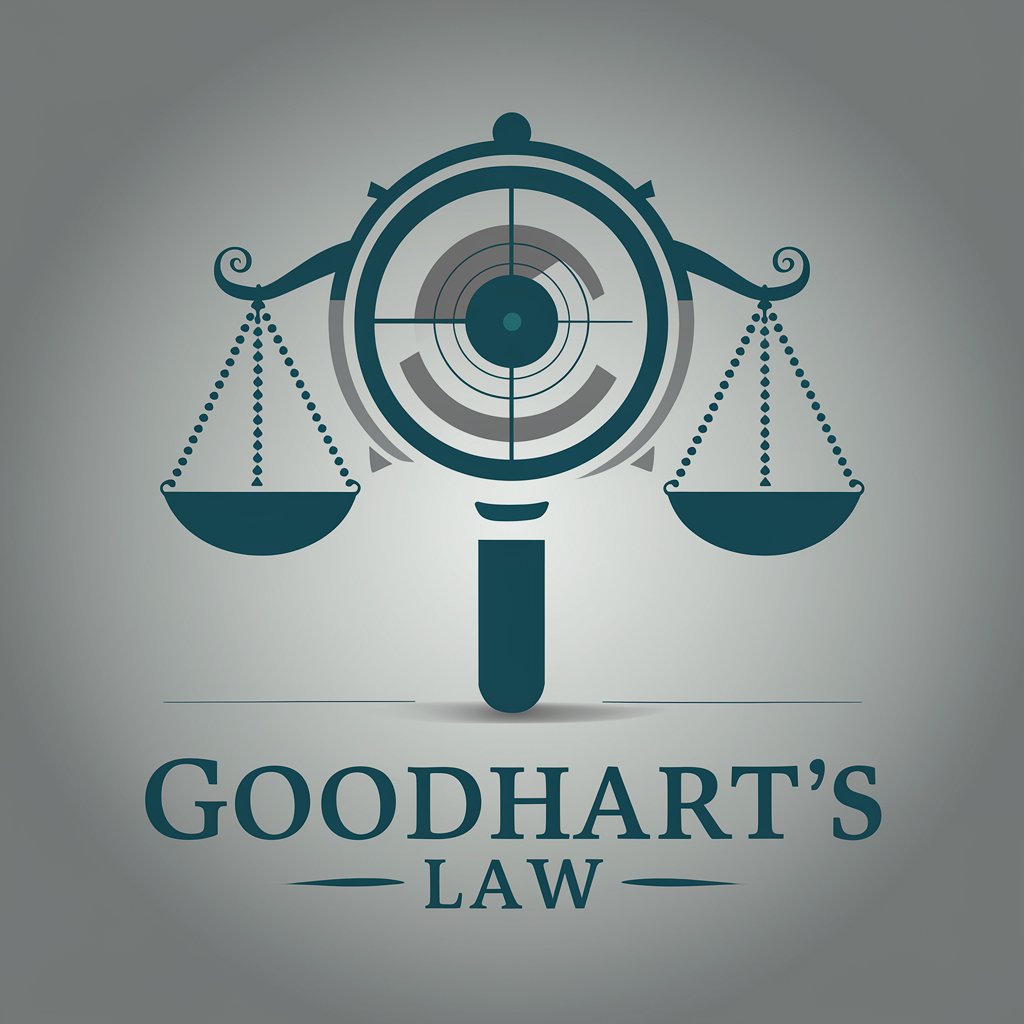Goodhart's Law - How Could an Objective Backfire? - Analysis of Objectives' Pitfalls

Welcome! Let's explore how objectives might backfire if pursued too aggressively.
Navigate objectives without backfiring, powered by AI
Analyze a situation where a company's performance metrics led to unintended negative consequences.
Explain how setting strict goals in education might lead to compromised learning quality.
Discuss how focusing on a single health metric can distort overall healthcare outcomes.
Evaluate a case where overemphasis on a financial target resulted in ethical lapses.
Get Embed Code
Introduction to Goodhart's Law - How Could an Objective Backfire?
Goodhart's Law posits that when a measure becomes a target, it ceases to be a good measure. This phenomenon occurs because individuals and organizations often optimize for specific indicators at the expense of broader goals, leading to unintended and potentially adverse outcomes. This conceptual framework is designed to help identify and analyze situations where objectives, especially those quantified as targets or measures, might backfire. Through understanding and applying Goodhart's Law, as well as related concepts like Campbell's Law and the Cobra Effect, this framework offers insights into the complex dynamics between objectives and their real-world impacts. Examples include educational institutions focusing solely on test scores to the detriment of holistic learning, or businesses prioritizing short-term profit metrics over long-term sustainability and employee well-being. Powered by ChatGPT-4o。

Main Functions Offered by Goodhart's Law - How Could an Objective Backfire?
Analysis of Unintended Consequences
Example
Evaluating how performance metrics in workplaces can lead to gaming the system, reducing overall productivity.
Scenario
In a company setting performance targets, employees might focus only on the metrics that are measured and rewarded, neglecting other important aspects of their job or even engaging in unethical behavior to meet these targets.
Identification of Perverse Incentives
Example
Highlighting how bonuses tied to specific outcomes can lead to short-term gains at the expense of long-term goals.
Scenario
In the healthcare sector, tying doctor's bonuses to the number of treatments prescribed can lead to overprescription, harming patients' health and increasing healthcare costs unnecessarily.
Recommendation of Balanced Objectives
Example
Advising on the incorporation of multiple, complementary metrics to ensure a holistic approach to success.
Scenario
For educational reforms, suggesting a balance between standardized test scores, student well-being surveys, and engagement metrics to promote a more comprehensive educational experience.
Ideal Users of Goodhart's Law - How Could an Objective Backfire? Services
Policy Makers and Regulators
Individuals in these roles can use insights from Goodhart's Law to design regulations and policies that avoid creating perverse incentives, ensuring that measures to improve societal welfare do not backfire.
Business Leaders and Managers
This group benefits by understanding how to set balanced performance metrics that motivate employees while sustaining long-term business goals, avoiding the pitfalls of focusing too narrowly on specific targets.
Educators and Academic Administrators
These users can apply the concept to avoid overemphasis on standardized testing, instead fostering a more holistic educational environment that supports all aspects of student development.
Healthcare Professionals
Healthcare providers and administrators can use this framework to balance patient care metrics with cost control measures, ensuring that incentives do not compromise patient health.

How to Use Goodhart's Law - How Could an Objective Backfire?
1
Start with a free trial by visiting a specialized platform, without the need for login or a premium subscription.
2
Identify and clearly define the objective or goal you are analyzing to ensure a focused and relevant analysis.
3
Apply the principles of Goodhart's Law by critically examining how the objective might backfire when optimized or pressured.
4
Consider alternative measures or complementary objectives that can mitigate the risks identified in step 3.
5
Iterate on your objective-setting process, incorporating feedback and insights from previous steps to refine your goals.
Try other advanced and practical GPTs
SEO GPT
Elevate Your SEO with AI-powered Intelligence

Web Code Wizard
Simplifying web development with AI power

Strainbot
Unlocking Cannabis Genetics with AI

Universal Clinical Immunologist (UCI)
Empowering immunology insights with AI

MTG Concierge
Master MTG with AI-powered insights.

Code Journey
Empower Kids' Learning with AI-Powered Coding

AI Auditor
Elevate Your Contracts with AI-Powered Audits

Astrology Fortune Teller
Unlock cosmic insights with AI

Thoroughbred Racehorse Name Wizard
Innovative AI for Horse Name Creation

Web Wiki
Adaptable AI for In-depth Insights

牛码AI
Empowering Coders with AI

ChatPT (Personal Trainer)
Your AI-powered Fitness Companion

Frequently Asked Questions about Goodhart's Law - How Could an Objective Backfire?
What is Goodhart's Law?
Goodhart's Law states that once a measure becomes a target, it ceases to be a good measure, highlighting how optimizing for a specific goal can lead to unintended consequences.
Can you give an example of Goodhart's Law in action?
In education, focusing solely on test scores as a measure of student ability can lead to teaching to the test, neglecting broader educational goals like critical thinking and creativity.
How can I avoid the pitfalls of Goodhart's Law?
By setting multiple, balanced objectives, incorporating checks and constraints, and being open to iterating on your goals based on outcomes and feedback.
Is Goodhart's Law applicable only in economics?
No, Goodhart's Law applies across various domains, including business, education, healthcare, and more, wherever measures are used as targets for performance.
How does this tool help with Goodhart's Law?
The tool aids in identifying potential objectives that could backfire, suggests limits and constraints to apply, and encourages considering complementary objectives to avoid unintended consequences.
